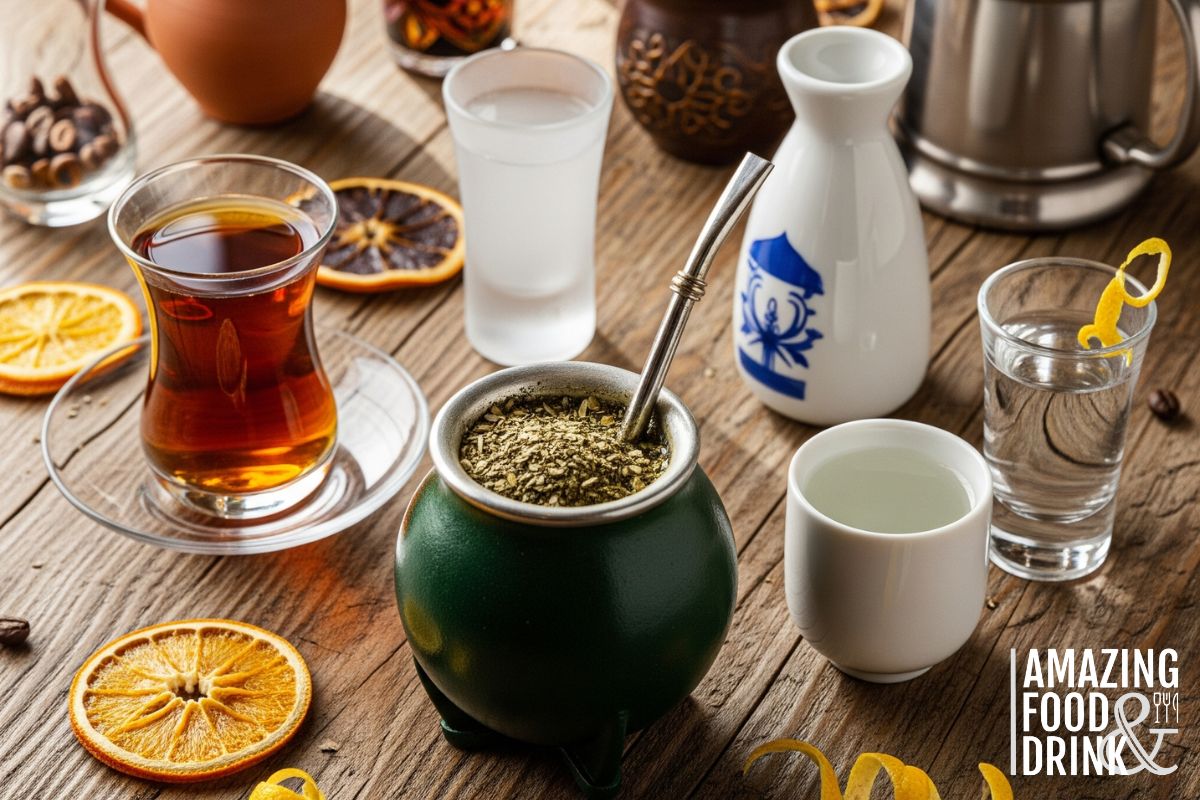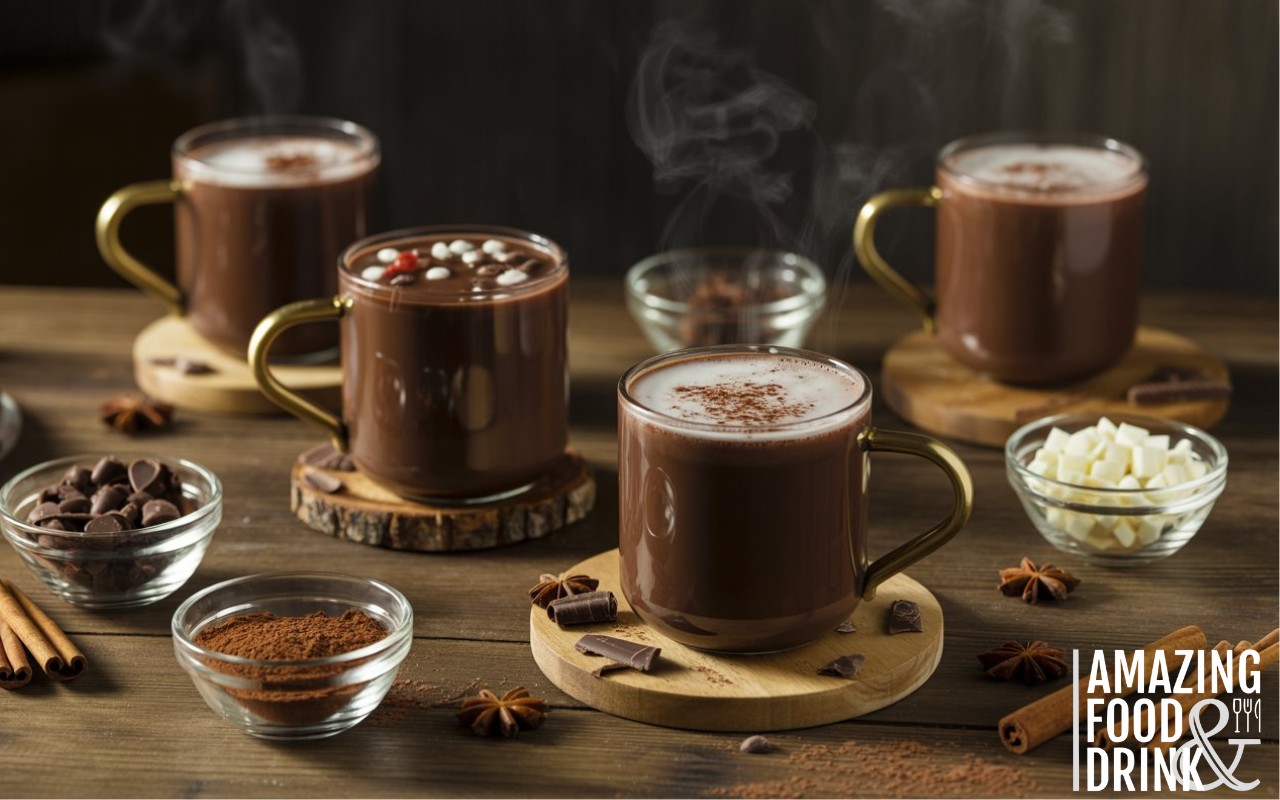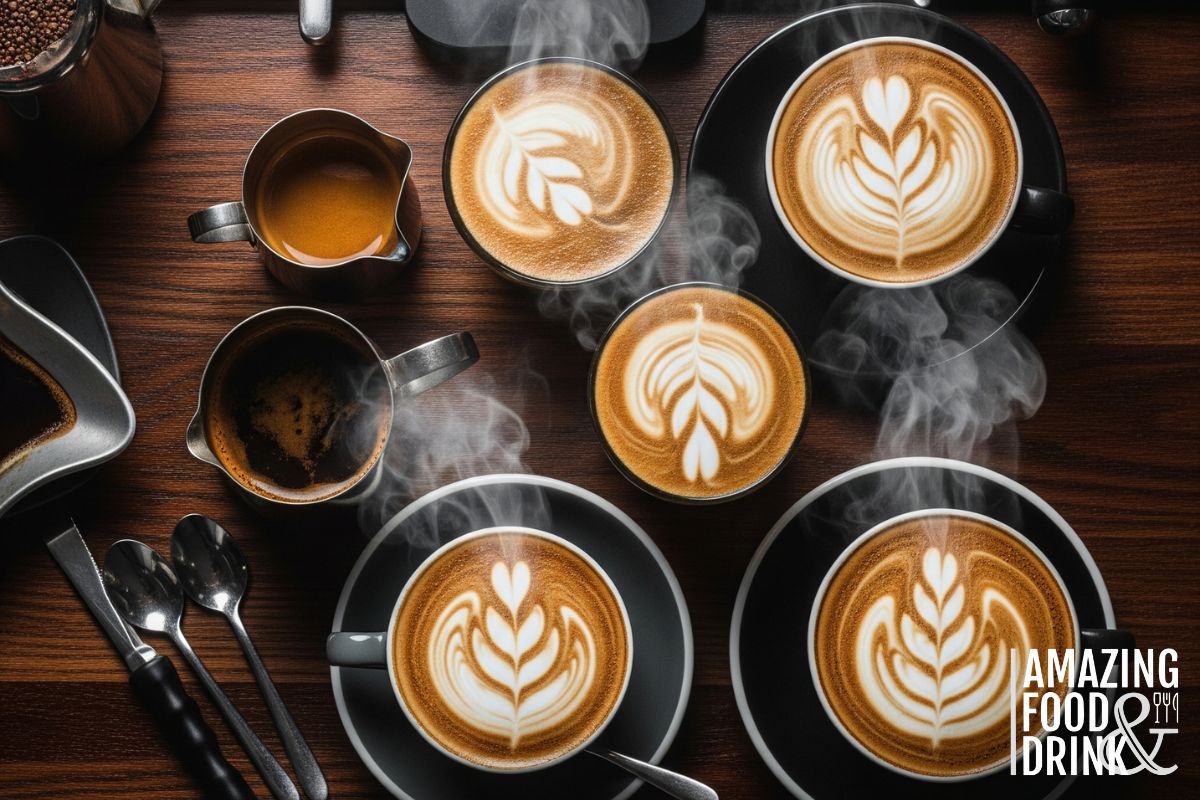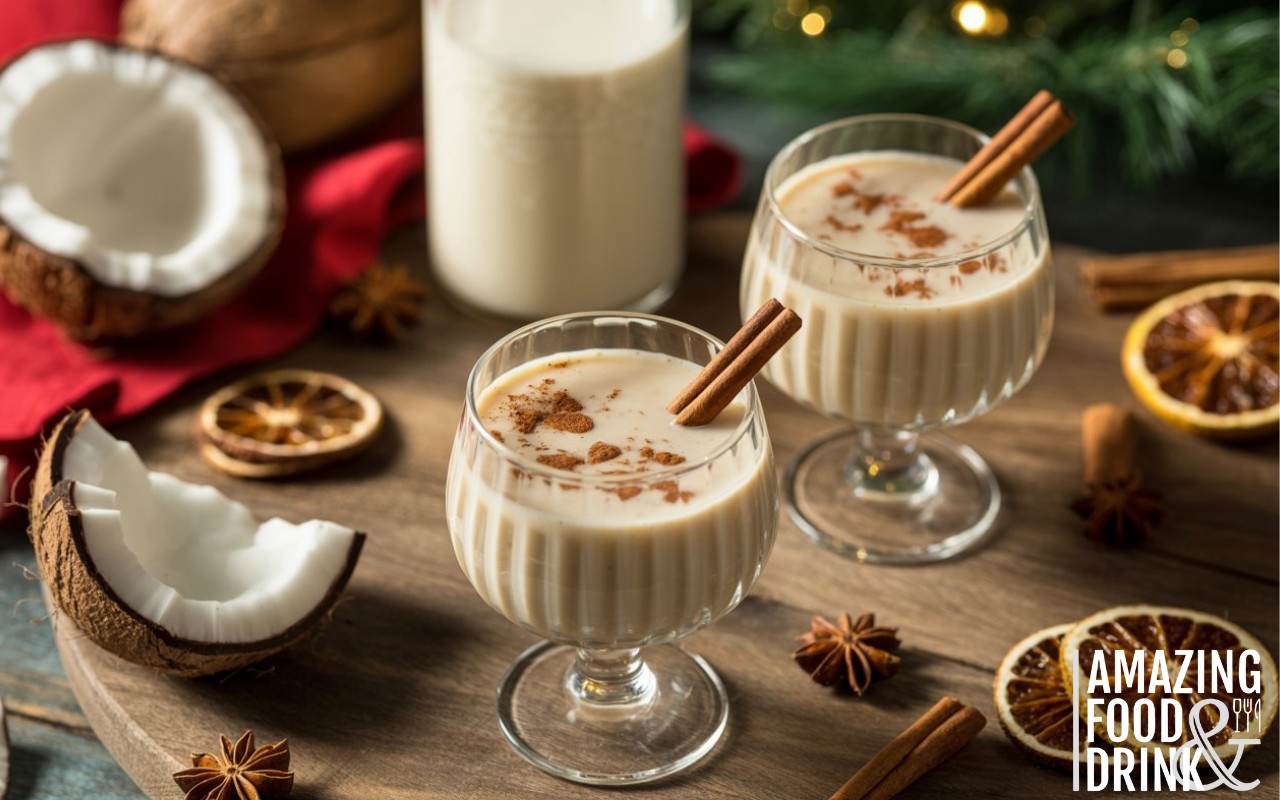Did you know that Taiwan’s beloved bubble tea was invented by accident in the 1980s when a tea shop owner decided to add tapioca balls to her drink? This happy accident became one of the world’s most recognisable national drinks, proving that the best traditional beverages often have the most unexpected origins.
Every country tells its story through flavours; nowhere is this more evident than in its signature drinks. From the energising ritual of Argentina’s maté to the refreshing fizz of New Zealand’s L&P, unique drinks from different countries offer us a liquid passport to explore diverse cultures without leaving our homes.
Table of Contents
- Global Beverage Trends
- Discover What’s Special
- Explore 12 Unique Drinks
- Create at Home
- Compare Health Benefits
The Global Rise of Traditional Beverages

In recent years, national drinks around the world have experienced unprecedented international popularity. What once remained within their country borders are now conquering global markets, with bubble tea shops appearing in London high streets and coconut water becoming a premium health drink in UK supermarkets.
This globalisation of traditional beverages represents more than just a food trend; it’s a cultural exchange through taste. Social media has accelerated this phenomenon, with Instagram-worthy drinks like colourful bubble tea and frothy teh tarik gaining millions of followers worldwide. The success stories prove that authentic flavours can transcend geographical boundaries when they offer unique experiences that mass-produced drinks cannot replicate.
What Makes a National Drink Special?

National beverages are far more than simple refreshments; they’re liquid storytellers that capture the essence of a nation’s identity. These drinks emerge from a perfect storm of local ingredients, climate conditions, historical events, and social customs.
Development patterns are fascinating to observe. Tropical nations often celebrate hydrating, fruit-based drinks like coconut water, while countries with abundant spice trade routes develop complex, aromatic blends like masala chai. Climate influences choices, too. Warming drinks dominate colder regions, while refreshing beverages reign supreme in warmer climates.
12 Traditional Beverages From Around the World
From the bustling tea stalls of Mumbai to the peaceful coconut groves of the Marshall Islands, these carefully selected drinks represent the pinnacle of their nation’s beverage culture. Each offers a unique window into local traditions, ingredients, and social customs that have shaped entire civilisations.
1. Maté (Argentina) – The Social Energy Booster

Argentina’s beloved maté (pronounced “mah-teh”) represents far more than a simple caffeine fix; it’s a cornerstone of Argentine social culture and one of South America’s most cherished traditional beverages.
This earthy, grassy drink comes from the yerba maté plant and contains moderate caffeine levels, typically less than coffee but more than most teas. What makes maté truly special is its communal consumption ritual. Argentines carry thermos flasks and maté gourds everywhere, sharing the drink through a metal straw called a bombilla.
- Flavour Profile: Distinctively earthy and slightly bitter with grassy undertones
- Caffeine Content: 30-50mg per serving (compared to coffee’s 95mg)
- Best Time to Drink: Morning energy boost or afternoon social gatherings
2. Masala Chai (India) – The Spiced Morning Ritual
India’s masala chai is one of the world’s most beloved cultural beverages. It transforms simple tea into an aromatic symphony of spices that awakens the senses.
This traditional drink combines four essential elements: robust black tea (usually Assam or Ceylon), whole milk, aromatic spices (cardamom, ginger, cinnamon, cloves), and a sweetener. The magic happens during the slow simmering process, where flavours meld into liquid perfection.
Essential Spice Blend:
- Cardamom (warming and fragrant)
- Fresh ginger (adds heat and aids digestion)
- Cinnamon (sweet warmth)
- Cloves (aromatic depth)
- Black pepper (subtle heat)
3. L&P (New Zealand) – The Kiwi Classic

Lemon & Paeroa, affectionately known as L&P, is New Zealand’s official soft drink and one of the most unique drinks from different countries you’ll encounter.
Created in 1904 when someone mixed lemon syrup with mineral water from Paeroa’s natural springs, this fizzy beverage captured Kiwi hearts with its distinctive lemony tang and crisp carbonation. Now owned by Coca-Cola, L&P remains distinctly New Zealand in character.
- Taste Description: Bright lemon flavour with mineral water crispness, imagine sparkling lemonade with a sophisticated twist.
- Cultural Significance: Featured in iconic “World Famous in New Zealand” advertising campaigns
4. Kinnie (Malta) – The Mediterranean Mystery
Malta’s national soft drink, Kinnie, offers one of Europe’s most intriguing flavour profiles among traditional drinks. Introduced in 1952, this bittersweet beverage combines bitter orange extracts with a secret blend of aromatic herbs.
The exact recipe remains closely guarded, but the result delivers a sophisticated alternative to mainstream soft drinks. Kinnie’s lower sugar content and complex herbal notes appeal to adult palates.
- Flavour Notes: Bittersweet citrus with herbal complexity, think Campari meets orange soda.
- Perfect Pairings: Mediterranean cuisine, particularly seafood and pasta dishes
- Where to Try: Malta’s restaurants and cafés, or order online through European import shops
5. Coconut Water (Marshall Islands) – Nature’s Sports Drink

In the Marshall Islands, coconut water isn’t just a trendy health drink; it’s a cultural necessity and the nation’s official beverage. This chain of Pacific atolls relies on coconut palms not just for food but also for hydration.
Fresh coconut water offers natural electrolytes, superior to many commercial sports drinks. The Marshall Islands version comes straight from young green coconuts, requiring no processing or additives.
Taste Difference: Fresh coconut water tastes mildly sweet with subtle nutty notes, quite different from the processed versions available in UK supermarkets.
6. Bubble Tea (Taiwan) – The Global Phenomenon
Taiwan’s bubble tea, or boba tea, represents one of the most successful international beverages for achieving global stardom. This chewy, sweet drink has conquered taste buds from London to Los Angeles.
The signature element, chewy tapioca pearls, transforms ordinary tea into an interactive drinking experience. These “bubbles” are made from tapioca starch and require special wide straws for consumption.
Popular UK Variations:
- Classic milk tea with black tapioca pearls
- Taro flavour (purple and mildly sweet)
- Thai tea with orange colour and spiced flavour
- Fresh fruit varieties with popping boba
Where to Find: Major UK cities now boast bubble tea shops, try Gong Cha, Mooboo, or local independent shops in Chinatowns.
7. Thobwa (Malawi) – The Fermented Tradition

Malawi’s traditional thobwa represents one of Africa’s most distinctive national beverages. This fermented drink, made from maise, sorghum, or millet, offers a tangy, slightly sour flavour with porridge-like consistency.
The fermentation process creates natural probiotics, making thobwa both nutritious and culturally significant. Families often prepare large batches for community gatherings and celebrations.
- Preparation Method: Grains are ground, mixed with water, and left to ferment for 2-3 days
- Texture: Thick and slightly grainy, similar to drinking yoghurt
- Cultural Role: Often served at traditional ceremonies and community events
8. Teh Tarik (Malaysia) – The Pulled Tea Spectacle
Malaysia’s teh tarik elevates simple milk tea into performance art. The name means “pulled tea,” referring to the dramatic preparation method where tea is poured between containers from great heights, creating a frothy, well-mixed drink.
This traditional beverage combines strong black tea with sweetened condensed milk, but the magic lies in the “pulling” technique that aerates the mixture and creates the signature foam top.
- The Pulling Technique: Masters pour tea from containers held up to three feet apart, creating long streams that cool the tea and develop the froth
- Served in: Clear glasses to showcase the frothy layer
- UK Availability: Malaysian restaurants in London, Manchester, and Birmingham often serve authentic versions
9. Golden Apple Juice (Saint Vincent and the Grenadines) – Caribbean Sunshine

This Caribbean nation’s national drink comes from the golden apple (June plum), a tropical fruit completely different from yellow apples. The resulting juice perfectly balances sweet and tangy flavours that embody the Caribbean spirit.
- Taste Profile: Sweet-tart with tropical fruit complexity, imagine a cross between mango and pineapple with citrusy notes
- Seasonal Availability: Best during Caribbean summer months (June-August)
- Nutritional Value: High in vitamin C and natural fruit enzymes
10. Almdudler (Austria) – The Alpine Herb Refresher
Austria’s Almdudler proves that unique drinks from different countries don’t need to be exotic to be special. This carbonated soft drink, made from Alpine herbs, has been Austria’s beloved alternative to international cola brands since the 1950s.
The secret blend of Alpine herbs creates a refreshing, slightly medicinal taste that Austrians associate with mountain freshness and outdoor activities.
Varieties Available:
- Original (full sugar)
- Sugar-free
- Still (non-carbonated)
- Mixed with mineral water
Cultural Connection: Strongly associated with Austrian outdoor culture, skiing, and mountain hiking
11. Atay (Morocco) – The Hospitality Symbol

Moroccan mint tea, known locally as “atay,” is one of the world’s most ceremonial traditional beverages. This sweet, minty drink is the cornerstone of Moroccan hospitality and social interaction.
The preparation ritual involves gunpowder green tea, fresh spearmint, and generous amounts of sugar, all served in small glasses after being poured from impressive heights to create foam.
The Ceremony:
- First glass: “Gentle as life”
- Second glass: “Strong as love”
- Third glass: “Bitter as death”
Preparation Secrets: The tea is poured and returned to the pot multiple times to achieve perfect mixing and temperature
UK Availability: Moroccan restaurants and Middle Eastern shops stock the proper ingredients
12. Kava (American Samoa) – The Social Sedative
American Samoa’s kava is one of the Pacific’s most culturally significant national drinks. Made from the ground root of the kava plant, this earthy beverage produces mild relaxation effects and plays a central role in Samoan social customs.
Preparation: Kava root is cleaned, dried, and ground into powder, then mixed with water and strained
Effects: Mild relaxation and social euphoria, perfectly legal and non-alcoholic
Cultural Importance: Shared during important social gatherings, ceremonies, and community discussions
Taste Warning: Kava tastes distinctly earthy and bitter. It is definitely an acquired taste, but the social experience makes it worthwhile.
How to Try These Drinks at Home
Bringing the world’s flavours into your kitchen doesn’t require extensive travel or expensive ingredients. Many of these international beverages can be recreated with items available in UK supermarkets, whilst others require just a few speciality ingredients ordered online.
Easy Starters for UK Residents:
Masala Chai: Purchase pre-mixed spice blends from Tesco or make your own with cardamom, ginger, and cinnamon
Bubble Tea: Order tapioca pearls online and experiment with different tea bases and milk combinations
Moroccan Mint Tea: Find gunpowder green tea and fresh spearmint at most supermarkets
Harder to Source: Maté: Order yerba maté and a gourd from Amazon or South American import shops
Kava: Available from speciality online retailers, but check UK import regulations.
L&P: Occasionally available in international sections or New Zealand import shops
Health Benefits Comparison

Many national drinks around the world offer impressive health advantages that surpass their commercial counterparts. They combine traditional wisdom with natural ingredients that have sustained populations for centuries.
Caffeine Content and Energy Benefits
Natural caffeine sources found in these traditional beverages provide sustained energy without the harsh crashes associated with commercial energy drinks. Maté delivers moderate caffeine (30-50mg per serving) alongside vitamins A, C, and E, making it a superior alternative to coffee for those seeking gentler stimulation. Masala chai offers similar moderate caffeine levels, whilst the included spices aid digestion and provide antioxidant benefits.
Natural Hydration and Electrolytes
Coconut water stands out as nature’s perfect sports drink, providing natural electrolytes including potassium, sodium, and magnesium with only 45 calories per cup. This makes it superior to artificial sports drinks that often contain excessive sugars and artificial additives.
Probiotic and Digestive Health
Fermented beverages like Malawi’s thobwa provide natural probiotics that support digestive health and immune function. These traditional fermentation processes create beneficial bacteria that commercial drinks cannot replicate, offering around 80 calories per serving alongside valuable fibre content.
Where to Find These Drinks in the UK

The UK’s diverse cultural landscape means that authentic versions of these national drinks around the world are often more accessible than you might expect. From specialist import shops to mainstream supermarkets, the growing demand for international beverages has made many of these drinks readily available.
London Hotspots:
- Chinatown: Bubble tea, teh tarik
- Brick Lane: Masala chai, Moroccan mint tea
- South Kensington: International supermarkets with global drink selections
Manchester & Birmingham: Large international communities mean better availability of authentic ingredients and prepared drinks
Online Options: Amazon, speciality import websites, and international food delivery services increasingly stock these international drinks.
These 12 beverages prove that every nation has stories to tell through flavours. Each drink offers affordable cultural adventures, from the communal ritual of sharing Argentine maté to the theatrical preparation of Malaysian teh tarik.
Whether planning international travels or exploring global flavours from home, these drinks provide authentic tastes of distant cultures. Each represents centuries of tradition, local pride, and cultural identity distilled into liquid form.
FAQs
1. What is the most popular national drink in the world?
Tea-based drinks dominate globally, with masala chai and various tea preparations most widely consumed due to historical trade routes and cultural spread.
2. Which countries have non-alcoholic national drinks?
Most countries featured here celebrate non-alcoholic beverages as their national drinks, including Argentina (maté), India (masala chai), and Taiwan (bubble tea).
3. How do you prepare traditional maté?
Fill a gourd 2/3 with yerba maté, insert the bombilla straw, add cool water first, then hot (not boiling) water, and share among friends using the same straw; it’s part of the tradition!
4. What does bubble tea taste like?
Bubble tea tastes like sweet, creamy tea with chewy tapioca pearls. The tea base can range from black tea to fruit flavours, whilst the pearls add textural interest rather than strong flavour.
5. Which national drink is easiest for beginners to try?
Masala chai is the most accessible starting point for exploring national drinks around the world. Most UK supermarkets stock the basic ingredients (black tea, milk, cardamom, ginger, cinnamon), and the preparation method is forgiving for beginners.



